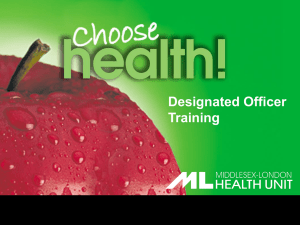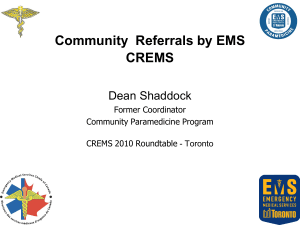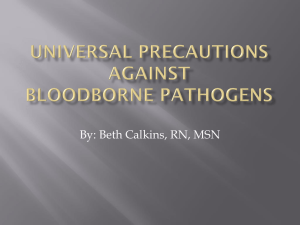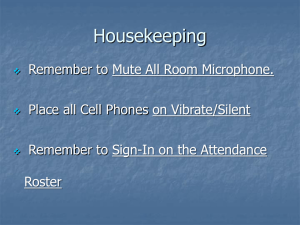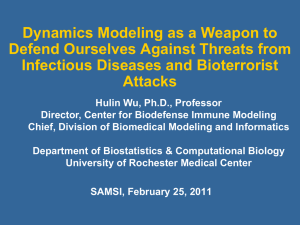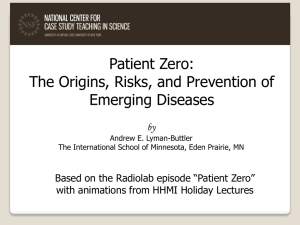AEMT Transition - Unit 20
advertisement
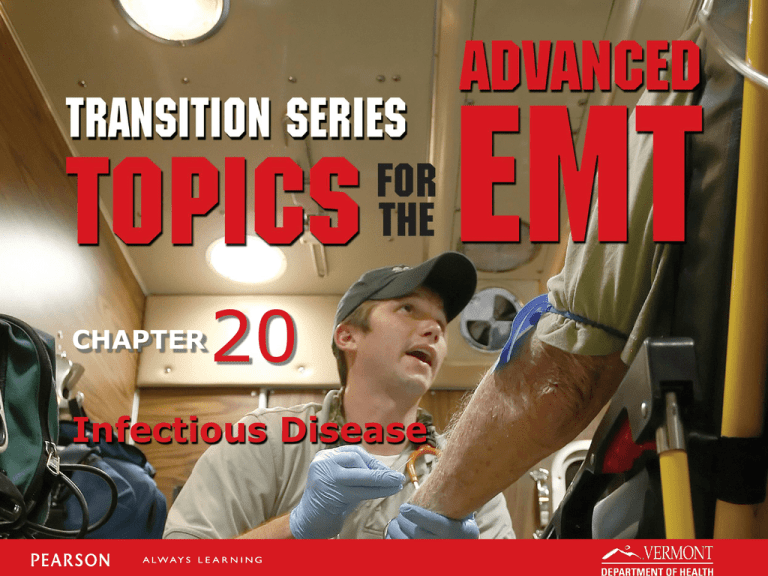
TRANSITION SERIES Topics for the Advanced EMT CHAPTER 20 Infectious Disease Objectives • Learn how infection spreads and how to protect yourself from disease. • Identify multi-resistant organisms. • Discuss influenza. • Recognize current infectious diseases prevalent in the community. • Discuss the role of EMS in public health. Introduction • From the common cold to multiresistant organisms, infectious disease is a topic that should be on every provider’s mind. • Today’s Advanced EMTs are faced with not only protecting themselves from microorganisms but also preparing for pandemic outbreaks and medicationresistant diseases. Introduction (cont’d) • This topic will focus on the evolving threats that infectious disease poses to the Advanced EMT and discuss the key concepts in personal protection. Spreading Infection • Infectious disease is defined as pathogenic microorganisms that can spread directly or indirectly from one person to another. – Bacteria – Viruses – Parasites – Fungi Spreading Infection (cont’d) • Communicable disease is one that is transmitted easily from one person to another. • Standard precautions help to prevent the transmission of disease. Standard Precautions are required to protect you from disease. Spreading Infection (cont’d) • Bloodborne diseases pose a particular threat to the Advanced EMT. • Advanced skills such as intravenous therapy and medication administration require the use of needles and other sharps that can pose a serious risk of injury when not used safely. Communicable Diseases Epidemiology • The Center for Disease Control and Prevention (CDC) estimates that roughly 82% of healthcare workers being exposed to bloodborne diseases occur as a result of needle or sharprelated incidents. • Improved safety strategies have demonstrated a 96% decline in the number of incidents since 1983. Hepatitis • Translates into inflammation of the liver. • Generally caused by a viral infection. • Classified as hepatitis A, B, C, D, or E. – A and E – food and waterborne – B, C, and D – bloodborne • CDC estimates roughly 80,000 new infections of hepatitis in the U.S. each year. Hepatitis (cont’d) • Hepatitis virus seeks out healthy liver cells and invades them. • Reproduction destroys these cells and causes an immune response in the liver. • Liver destruction occurs both immediately and over a period of time while the disease persists. Hepatitis (cont’d) • Chronic hepatitis – Long term decline in the function of the liver • Acute hepatitis – Short term, “flare ups” • Roughly 4.4 million Americans live with chronic hepatitis and are essentially asymptomatic Hepatitis (cont’d) • Signs and symptoms – Fatigue – Abdominal pain – Nausea – Vomiting – Jaundice HIV/AIDS • Human immunodeficiency virus (HIV) is a bloodborne pathogen that potentially leads to acquired immune deficiency syndrome (AIDS). • The CDC estimates that slightly fewer than 700,000 Americans are infected with HIV. HIV/AIDS (cont’d) • AIDS affects the immune system by destroying essential T cells thus leaving the body vulnerable to opportunistic infections. • Most AIDS deaths are caused by secondary diseases such as respiratory infections and malignancies. HIV/AIDS (cont’d) • Bloodborne disease transmitted through needle stick and sharp-related injuries. • Only about 3 in 1000 needle stick injuries will actually transmit disease. HIV/AIDS (cont’d) • Factors that contribute to the probability of transmission – Amount of blood on or in the sharp – How deep the needle penetrated – Whether or not it penetrated an artery or vein – How high the viral load in the patient Tuberculosis • Spread by a bacterium known as Mycobacterium tuberculosis. • Transmitted through respiratory droplets. • Roughly ⅓ of the world’s population is currently infected with the TB bacillus. Tuberculosis (cont’d) • Vast majority have latent tuberculosis. • Those at higher risk are drug users, HIV patients, and those in congregate settings. Tuberculosis (cont’d) • Active TB develops in 5-10% of those exposed. • Characterized by a massive immune response in the lining of the airway and parenchymal tissue. • Inflammation and lung cell changes cause poor diffusion and destruction of lung tissue. Tuberculosis (cont’d) • Signs and symptoms – Blood tinges sputum – Fever – Weight loss – Night sweats • N-95 type respirator protects from droplet transfer of tuberculosis. Multidrug-Resistant Organisms • Enhanced by partial and unfinished courses of antibiotic treatment. • Bacteria is exposed to the medication but is not completely eradicated when the full course of treatment is not received. • Remaining bacteria reproduce and develop resistance. MRSA • Methicillin-Resistant Staphylococcus aureus • About 25% of the population carries staphylococcus bacteria on their skin/nose. MRSA (cont’d) • Transmitted by skin or respiratory contact • Divided into two groups – Hospital-acquired – Community-acquired MRSA (cont’d) • Remember as an EMS provider, you are exposed to Staphylococcus aureus and MRSA every day. • MRSA can be transmitted by skin contact and/or by respiratory contact. • Utilize the appropriate level of personal protective equipment to prevent the spread of bacteria. Hand washing is vital for preventing the spread of disease. Handwashing • When washing, remember the key elements to proper handwashing – Warm flowing water and soap – At least 15 seconds of scrubbing over all the surfaces – Thorough rinsing Alcohol-based hand cleaner is effective and can be used when soap and water are not available. Influenza • Influenza (flu) is a viral infection that has multiple different classifications and subclassifications. – Influenza A, B, C – H1N1, H5, N1 • Various strains of influenza strike regionally each year. Influenza (cont’d) • The Center for Disease Control and Prevention estimates that influenza kills somewhere between 3,000 and 50,000 people each year in the United States. • In 2009, Influenza A (H1N1) killed more than 18,000 people and was found in 214 countries. • The WHO designated H1N1 a pandemic. Influenza (cont’d) • Influenza is quite virulent. • Spread via airborne droplets and through contact with respiratory fluids. • Immune response causes inflammation and changes in the lining of the respiratory tract. • Cytokines and other chemicals released from infected cells cause S/S. Influenza (cont’d) • Signs and symptoms – Fever – Fatigue – Chills – Muscle pains – Cough Influenza (cont’d) • EMS is at high risk to be exposed. • Consider getting vaccinated each year. • Protect yourself from respiratory droplet contact in patients with a high suspicion of influenza. • Handwashing and decontamination are essential. EMS and Public Health • EMS has developed a significant responsibility within public health. • Especially in the context of infectious disease. • EMS frequently partners with other health care entities to develop and enact strategies to prevent and stop the spread of infectious disease. EMS in the public health setting. EMS in the public health setting. EMS as an Agent of Public Health Summary • It is imperative that all EMS providers protect themselves from, and prevent the spread of, infectious disease. • As diseases become challenging to fight, partnerships continue to develop in health care to provide an optimal response. Summary (cont’d) • EMS plays a vital role in developing and carrying out action plans against disease.

